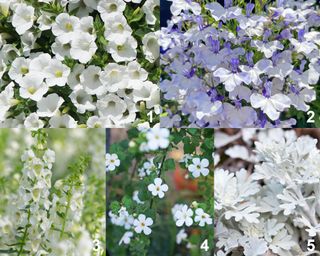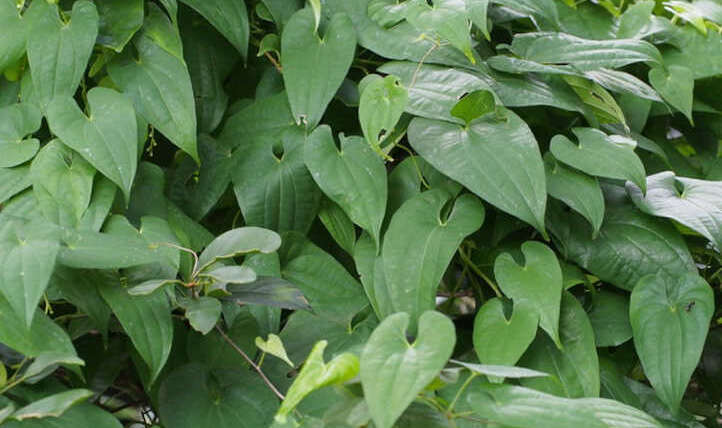Gardens are colorful, tranquil, and relaxing spaces. But how often can you take time to enjoy that cultivated beauty when the gardens are most vibrant and alive? You’re either working a day job, working in the garden, or working at the outdoor grill. When you’re ready to relax as the sun settles, flower and foliage colors become muted as the shadows creep in.
Extend the time you can enjoy your outdoor space by designing a garden that glows well into the evening. A moon garden is filled with plants that look good at night, featuring light and white blooms and silvery foliage that catch what ambient light remains once evening falls.
Relax well into the night with one of the five moon garden planting recipes that follow. Be sure the plants you choose are suited to your USDA Hardiness Zone and are appropriate for your existing light levels, soil type, and moisture conditions.
1. Contained Illumination
Whether used on a small balcony, an expansive patio or to highlight a pathway, containers filled with white-flowered annuals and light-colored foliage can prolong your enjoyment of the evening garden.
(Image credit: Shutterstock)
- Calibrachoa (Petunia hybrid) A cascading element in a container, calibrachoa’s small bell-like flowers come in white and light-colored pastels, many with streaked petals for a bit of visual interest. USDA Zones 9-11.
- Lobelia (Lobelia erinus) While blue lobelia are most popular, white, light blue and blue-and-white bicolors of this small-flowered annual glow in the evening’s pale light. USDA Zones 9-11.
- Angelonia (Angelonia hybrid) Angelonia’s 2-3ft-tall flower spikes create a visual peak in any container combination. USDA Zones 9-11.
- Bacopa (Sutera cordata) Spilling out of a container, bacopa’s dark leaves offer that perfect visual contrast to illuminate its yellow-throated white flowers. USDA Zones 9-11.
- Dusty Miller Silver Cascade (Artemisia stelleriana) This is one of several silver-leaved and cascading foliage plants that can elongate the look of your container combo while helping it glow well into the evening. USDA Zones 3-9.
2. Shimmering Tropicals
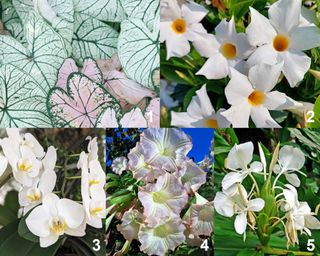
(Image credit: Shutterstock)
The benefits of this moon garden filled with tropical plants are twofold: it shimmers in evening light and naturally low-light locales such as urban gardens.
- Caladium (Caladium hortulanum) Many varieties incorporate white- and rose-colors splashes on broad, heart-shaped leaves, such as ‘White Star’, ‘Snow Flurry’, and ‘White Wonder’. Use in containers or garden bed en masse. USDA Zones 10-11.
- Mandevilla (Mandevilla hybrids) Use the white and light pink-flowered versions of this tropical vining plant to illuminate dark corners or in containers. USDA Zones 9-11.
- Moth Orchid (Phalaenopsis amabilis) Also known as the moon orchid, its flower stalks are lined with a dozen or more broad flowers. White and light colored flowers sparkle like fireflies in the evening light. USDA Zones 10-12.
- Angel’s Trumpet (Brugmansia suaveolens) This small show-stopping shrub offers pendulous flowers in white and light colors. Best placed near the back of a full sun urban garden, it catches light from the moon and twinkle lights equally well. USDA Zones 9-11.
- Butterfly Ginger Lily (Hedychium coronarium) The dark leaves of this 3-6ft-tall tropical perennial provide a backdrop of its intricate, bright white and intoxicatingly fragranced flowers. USDA Zones 8-11.
3. Glowing On For Years
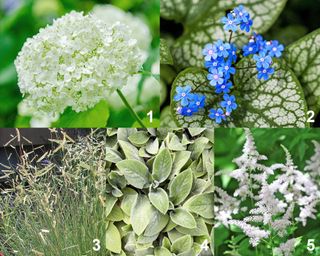
(Image credit: Alamy / Shutterstock)
Creating a moon garden with perennials allows you to plan your twilight retreat for years of enjoyment.
We have created a Moon Garden planting plan in collaboration with Plant By Number, available from the Gardening Know How Shop. The design will perfectly fill a 7ft x 5ft garden space near a porch, alongside your home, or bordering your perimeter.
The layout is printed on weed-blocking fabric for minimal maintenance and to ensure quick and easy installation with perfect plant spacing every time. You will also receive a plant shopping card to help you find everything you need in your local plant nursery or garden center.
The plants are selected to catch the moonlight. All varieties here are suited for USDA Zones 4-8:
- Annabelle Hydrangea (Hydrangea arborescens) With large, spherical white blooms, use this hydrangea as the garden’s foundational planting.
- Brunnera ‘Jack Frost’ (Brunnera macrophylla) Another low-growing plant, this one shines with an intricate silvery lace pattern on dark green, heart-shaped leaves. Airy sprays of tiny blue flowers appear in midspring.
- Blue Grama Grass ‘Blonde Ambition’ (Bouteloua gracilis) This light-colored grass will add movement to the garden as its stems and unique flag-like seed heads catch the evening breeze. Grows 3ft tall and wide.
- Lamb’s Ear ‘Helen Von Stein’ (Stachys byzantina) This low-growing silvery foliage plant adds light colors and a fun fuzzy texture in a mounding habit. Bonus – it’s drought-tolerant!
- Astilbe ‘Visions in White’ (Astilbe chinensis) White feathery plumes not only add texture and brightness to this moon garden from midsummer to fall, but they also sway in the breeze. Grows to 2ft tall.
4. Golden Treasures
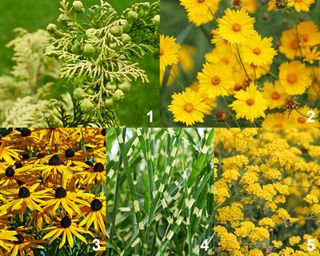
(Image credit: Shutterstock)
Yellows and chartreuses also prolong the glow of the evening garden. Consider gold-tinged evergreens, bicolor ornamental grasses, and the yellows of some popular perennials.
- Golden Hanoki False Cypress (Chamaecyparis obtusa ‘Crippsii’) The bright golden foliage of this evergreen ensures four seasons of interest in your moon garden. Use as the garden’s hedge or as a tall (8-10ft) focal plant. USDA Zones 4-8.
- Tickseed (Coreopsis hybrids) A number of pale to golden yellow varieties of tickseed are available to light up your night. Blooming in late spring through fall, their 12-14 inch height is just the size for the front of your moon garden. USDA Zones 5-9.
- Black-Eyed Susan (Rudbeckia fulgida var. sullivantii ‘Goldsturm’) The masses of cone-shaped flowers will dominate the late summer garden and glow each evening. Use in groups, alternating with the ornamental grasses. USDA Zones 4-9.
- Zebra Grass (Miscanthus sinensis ‘Zebrinus’) Its broad strapping medium green leaves are ringed with stripes of yellow, giving it a distinctive glow in the evening garden. Foliage matures to a rich golden 5-9.
- Basket-of-Gold (Alyssum saxitale) Plant this low-growing golden-hued perennial along your golden moon garden’s border for its prolific burst of springtime color. USDA Zones 4-10.
5. Moths By Moonlight
Moths are important pollinators, but because they are most active at night, their needs are often overlooked. Plants that attract moths are heavily scented during the evening hours, such as the following.
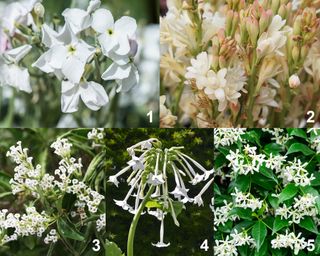
(Image credit: Alamy / Shutterstock)
- Night-Scented Stock (Matthiola longipetala) An old-fashioned variety, it’s an easy and elegant flower in shades of rose, pale pink and white. Grows to about 2ft tall. USDA Zone 10.
- Tuberose (Polianthes tuberosa) This summer-flowering bulb has an evening-induced and intoxicating gardenia-like fragrance. Flower stalks reach 3-4ft tall and bloom July through September. USDA Zones 7-8.
- Night-Blooming Jasmine (Cestrum nocturnum) This is a broadleaf columnar evergreen growing to up to 10ft tall, making it an excellent property hedge or backdrop for your moon garden. Amazing fragrance. USDA Zones 9-11.
- Flowering Tobacco (Nicotiana sylvestris) Varieties that are white and light pinks and greens shine the most in the evening, and their fragrance is intoxicating. Grows to about 4-5ft high. USDA Zone 10.
- Star Jasmine (Trachelospermum jasminoides) Another jasmine-like scented flower, star jasmine is an evergreen climbing vine, and can reach up to 12ft tall. Use in a pot so it can be sheltered inside over winter. USDA Zones 8-10.
With stunning planting recipes like these, you may never step foot in your garden during the day again.
This article features products available from third-party vendors on the Gardening Know How Shop.


